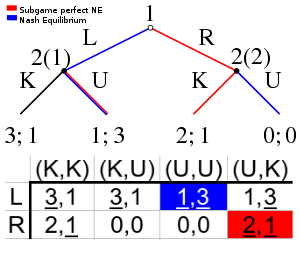Non-credible threat

A non-credible threat is a term used in game theory and economics to describe a threat in a sequential game that a rational player would actually not carry out, because it would not be in his best interest to do so.
For a simple example, suppose person A walks up, carrying a bomb, to another person B. A tells B he will set off the bomb, killing them both, unless B gives him all his money. If A is rational and non-suicidal he stands nothing to gain from setting off the bomb, so his threat cannot be considered credible. On the other hand, a person in the situation of B might give A his money, fearing that A is not rational, or might even be suicidal.
A non-credible threat is made on the hope that it will be believed, and therefore the threatening undesirable action will not need to be carried out. For a threat to be credible within an equilibrium, whenever a node is reached where a threat should be fulfilled, it will be fulfilled. Those Nash equilibria that rely on non-credible threats can be eliminated through backward induction, the remaining equilibria are called subgame perfect Nash equilibria.
